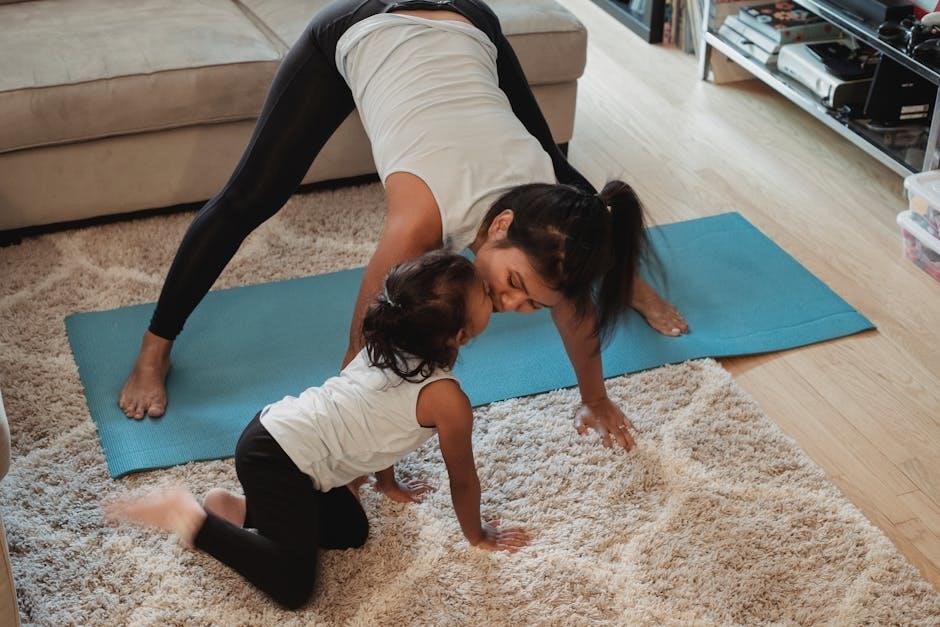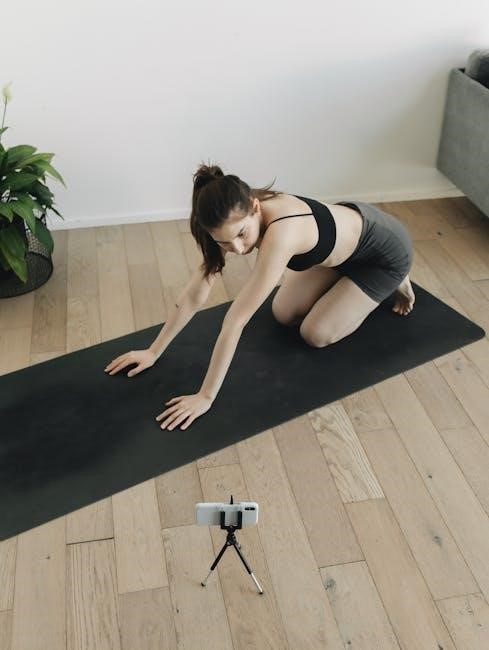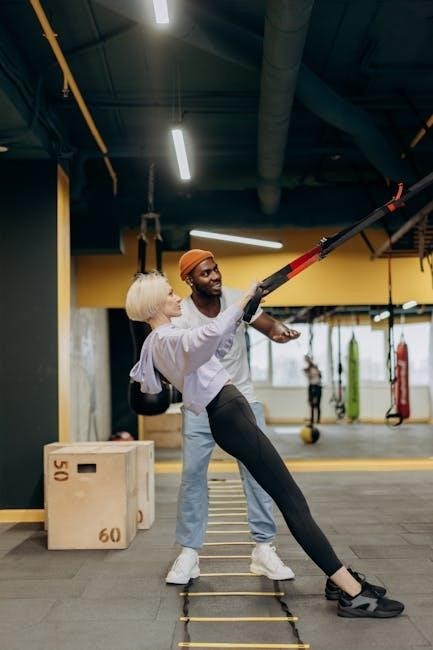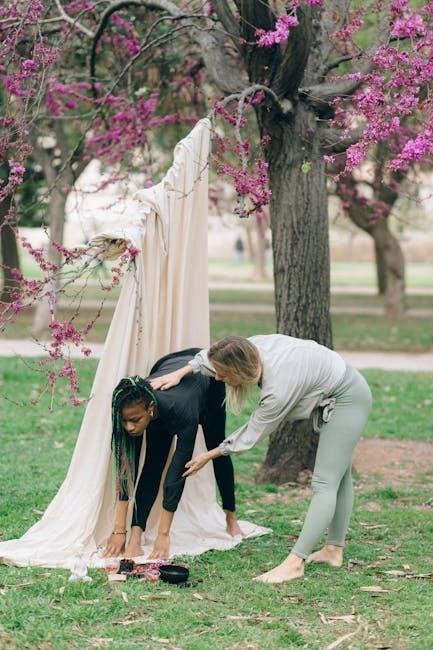
ear stretching guide
Ear stretching, or ear gauging, is the practice of gradually enlarging pierced earlobes for aesthetic purposes. Originating from ancient cultures, it has evolved into a popular form of self-expression worldwide.

1.1 What is Ear Stretching?
Ear stretching, also known as ear gauging, is the gradual enlargement of pierced earlobes to accommodate larger jewelry. It involves increasing the diameter of the piercing over time, creating a larger hole. This practice, considered a form of aesthetic body modification, allows individuals to wear various types of jewelry, such as plugs, tunnels, or spirals; The process requires patience, as it is typically done incrementally, allowing the skin to heal before further stretching. Ear stretching is a popular way to express personal style and cultural identity, with techniques ranging from manual methods to specialized tools like tapers or tapes.
1.2 Brief History and Cultural Significance
Ear stretching has deep roots in ancient cultures, with evidence of its practice found in tribes across Africa, Asia, and South America. In many Indigenous communities, enlarged earlobes symbolized spiritual or tribal identity, often signifying status or connection to heritage. For instance, the Mursi people of Ethiopia are known for their lip and ear plates, which hold cultural and aesthetic significance. Similarly, in some Native American and South Pacific cultures, ear stretching was a rite of passage or spiritual ritual. Today, this practice has been adopted globally, blending ancient traditions with modern aesthetics, making it a diverse and inclusive form of self-expression.

Understanding the Ear Stretching Process
Ear stretching is a gradual process requiring patience and proper techniques. It involves enlarging pierced earlobes safely by introducing larger jewelry over time to achieve desired results.
2.1 Preparation for Stretching
Proper preparation is crucial before starting the ear stretching process. Ensure your piercing is fully healed, as stretching unhealed tissue can lead to complications. Clean your ears regularly with saline solution to maintain hygiene. Lubricate your earlobes with jojoba oil or another non-comedogenic oil to reduce friction. Massage your lobes gently to increase blood flow and flexibility. Avoid stretching if your skin is irritated or inflamed. Choose the right tools and jewelry for your desired method. Patience is key, as rushing the process can cause damage. Prepare mentally for a gradual journey, as stretching takes time and dedication to achieve optimal results safely.
2.2 Choosing the Right Materials
Selecting the right materials is essential for safe and effective ear stretching. Opt for high-quality jewelry made from biocompatible materials like glass, surgical stainless steel, or titanium. These materials reduce the risk of irritation and promote healing. Avoid cheap plastics, acrylics, or low-grade metals, as they can cause infections or reactions. Single-flare plugs are ideal for stretching, while double-flare designs may cause discomfort. Use tapers or stretchers specifically designed for ear stretching to ensure smooth progression. Always sanitize your tools and jewelry before use. Proper materials not only enhance comfort but also minimize risks, making the stretching process safer and more successful in achieving your desired results.

Popular Methods of Ear Stretching
Popular methods include taping, tapering, and dead stretching. Taping involves wrapping tape around plugs gradually, while tapering uses specialized tools for precise enlargement. Dead stretching is done without tools.
3.1 The Taping Method
The taping method involves wrapping non-adhesive tape, like Teflon or PVC, around your existing jewelry to gradually increase the size of the piercing. Start by cleaning the area thoroughly. Use a small amount of oil, such as jojoba, to reduce friction. Wrap the tape tightly but not too aggressively, ensuring it’s even around the plug. Over time, the ear will slowly stretch to accommodate the added thickness. Change the tape weekly to maintain hygiene. This method is cost-effective and allows for precise control, making it ideal for gradual enlargement without causing excessive stress to the tissue.
3.2 The Tapering Method
The tapering method is a popular technique for ear stretching, using a tapered tool to guide the jewelry through the piercing. Start by lubricating the earlobe and taper with oil, such as jojoba, to minimize friction. Insert the taper into the piercing, gently pushing it through until the desired size is reached. A companion plug is often used to finalize the stretch. This method is quick but requires caution to avoid over-stretching. It’s best performed after the piercing is fully healed. Begin with a smaller gauge and gradually increase to prevent tearing. Patience is key for a safe and successful outcome.
3.3 The Dead Stretching Method
The dead stretching method involves gradually increasing the size of an existing piercing without using tapers or taping. This technique relies on wearing progressively larger jewelry over time. Start by inserting a slightly larger plug into the healed piercing, allowing the skin to stretch naturally. Be patient, as this method requires months for noticeable results. Use high-quality, biocompatible materials like glass or stainless steel to minimize irritation. Massage with jojoba oil can aid in lubrication and blood flow. Avoid forcing the jewelry, as this can cause tearing. Dead stretching is ideal for those preferring a slower, low-maintenance approach to ear stretching.

Best Jewelry for Ear Stretching
Choosing the right jewelry is crucial for safe and effective ear stretching. Opt for high-quality, biocompatible materials like glass or stainless steel to promote healing and comfort.
4.1 Recommended Jewelry Types
For ear stretching, opt for high-quality, biocompatible materials to ensure comfort and proper healing. Single-flare glass plugs are highly recommended due to their smooth finish and ability to minimize irritation. Stainless steel and titanium jewelry are also excellent choices, as they are non-reactive and durable. Avoid acrylic or cheap metal plugs, as they can cause infections or discomfort. Additionally, steer clear of double-flare plugs during the stretching process, as they can put unnecessary pressure on the piercing. Always prioritize jewelry designed specifically for stretching to support the health and integrity of your earlobes during this process.
4.2 Avoiding Unsafe Materials
When selecting jewelry for ear stretching, it’s crucial to avoid materials that can cause irritation or infections. Acrylic and cheap metal plugs should never be used, as they can harbor bacteria and lead to complications. Plastic jewelry is also unsafe, as it may contain harmful chemicals. Additionally, avoid double-flared plugs during the stretching process, as they can cause unnecessary pressure and discomfort. Always opt for high-quality, non-reactive materials like glass, stainless steel, or titanium, which are designed for safe stretching. Prioritizing the right materials ensures a healthier and more comfortable ear-stretching experience, reducing the risk of infections or long-term damage.

Aftercare and Healing
Proper aftercare is essential for healing. Wash piercings twice daily, soak in saline, and massage with jojoba oil to promote healing. Patience is key—allow ample time between stretches to ensure full recovery and avoid complications.
5.1 Daily Cleaning Routine
A consistent daily cleaning routine is crucial for maintaining ear stretching hygiene. Wash your hands thoroughly before handling your piercings. Use a saline solution to gently soak the area twice a day, ensuring all debris is removed. Avoid harsh soaps or chemicals that can irritate the skin. After soaking, pat the area dry with a clean, disposable towel. Regular cleaning helps prevent infections and promotes healthy healing. Additionally, consider using a piercing aftercare spray for convenience, but always opt for fragrance-free and alcohol-free products to avoid irritation. Diligence in cleaning will support the overall health of your stretched ears.
5.2 Massage and Lubrication Techniques
Massaging and lubricating your stretched ears is essential for promoting healing and maintaining flexibility. Use a natural oil like jojoba or coconut oil to gently massage the lobes in circular motions for 5-10 minutes daily. This stimulates blood flow, reducing stiffness and discomfort. Lubrication helps the skin stay healthy and prevents dryness. Avoid excessive oil application, as it can attract dirt. Regular massage also helps maintain the shape of the stretching and prevents the formation of unsightly scar tissue. Consistent practice ensures your ears remain supple and ready for further stretching when the time comes. Massage is a key component of aftercare.

5.3 Waiting Periods Between Stretches
Allowing adequate time between stretches is crucial for proper healing and to prevent damage. Most professionals recommend waiting at least 6 weeks to 6 months before increasing the size of your ear stretching. This period ensures the tissue has fully healed and strengthened. Rushing the process can lead to tearing or complications. During this time, the skin regenerates collagen, and the piercing becomes more stable. Patience is key to achieving long-term success and avoiding setbacks. Always wait until the area feels completely normal before proceeding to the next size. Proper waiting periods ensure a smooth and healthy stretching journey.

Safety and Risks
Ear stretching carries risks like infections, tearing, and scarring if improper techniques are used. Prioritize safe materials and professional guidance to minimize complications and ensure healthy outcomes.
6.1 Common Risks and Complications
Ear stretching can lead to complications like infections, scarring, and tearing if not done properly. Improper techniques or using low-quality materials can cause infections, while over-stretching may result in tears. Scarring, including keloid formation, is also a risk. Infections can be serious if left untreated, potentially leading to permanent damage. Tearing may require surgical repair, while keloids can be challenging to treat. These complications highlight the importance of following safe practices and using high-quality materials to minimize risks and ensure a healthy stretching process.
6.2 Preventative Measures
To minimize risks, proper preparation and care are essential. Wash your hands and piercings regularly with saline solution to prevent infections. Use high-quality, safe materials like glass or surgical steel to avoid irritation. Avoid stretching too quickly, as this can cause tears or permanent damage. Start with smaller gauges and gradually increase size to allow proper healing. Massage your lobes with jojoba oil to keep them healthy and flexible. Avoid tight clothing that may irritate the area. By following these steps, you can reduce the likelihood of complications and ensure a safe, successful stretching process.